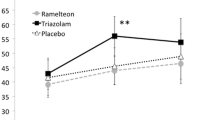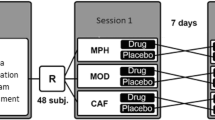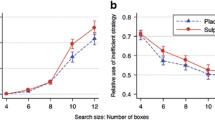Abstract
Twelve healthy subjects received single oral doses of 0.4 mg suriclone (SU), 7.5 mg zopiclone (ZO) and placebo, alone and together with 50 mg chlorpromazine (CP), double blind and crossover, in Latin square order, at one-week intervals. Performance tests administered before and 1.5, 3.5 and 6 h after drug intake included digit symbol substitution and simulated driving combined in a “Global test”, flicker fusion frequency, body balance and memory and subjective assessments. Changes from baseline were examined statistically. Performance and memory data were analysed from only 11 subjects.
Compared to placebo, SU minimally affected “global” performance, although it slowed reactions and tended to impair digit substitution. ZO impaired “global” performance at 1.5 h, affected performance in several separate tests, and produced subjective muzziness. CP did not impair “global” performance, although it did impair digit substitution and render the subjects drowsy, weak and dreamy. The combinations SU + CP and ZO + CP definitely impaired “global” performance more than CP alone. This difference was also found in most objective tests but less so in the subjective tests.
CP and its combinations produced similar increases in plasma prolactin. Active drugs and their combinations variably lowered blood pressure and increased heart rate, and one subject collapsed after CP. The treatments irregularly impaired spatial memory and learning acquisition.
No pharmacokinetic interactions were seen in the plasma levels of suriclone, zopiclone and chlorpromazine. The impairment of performance after these combinations resembles that previously encountered after 2.5 mg lorazepam, or 15 mg diazepam +100 mg remoxipride.
Similar content being viewed by others
Literatur
Blanchard JC, Julou L (1983) Suriclone, a new cyclopyrrolone derivative recognising receptors labelled by benzodiazepines in rat hippocampus and cerebellum. J Neurochem 40: 601–607
Garret C, Bardonne MC, Blanchard JC (1983) Suriclone, un novel anxiolytique de la famille des cyclopyrrollones, proprietes pharmacologiques et biochemiques. Acta Pharm Bioch Clin 2: 132–136
Trifiletti RR, Snyder SH (1984) Anxiolytic cyclopyrrolones zopiclone and suriclone bind to a novel site linked allosterically to the benzodiazepine receptor. Mol Pharmacol 26: 458–469
Burt DR, Kamatchi GL (1991) GABAA receptor subtypes: from pharmacology to molecular biology. FASEB J 5: 2916–2923
Gerlach J, Christensen JK, Rosted Christensen TL, Elley J, Stigaard Jensen P, Larsen SB (1987) Suriclone and diazepam in the treatment of neurotic anxiety. Psychopharmacology 93: 296–300
Ansseau M, Olie JP, von Frenckell R, Jourdain G, Stehle B, Guillet P (1991) Psychopharmacology 104: 439–443
Mattila MJ, Mattila ME, Nuotto E (1993) Measuring drug-alcohol and drug-drug interactions of psychotropic drugs on human skilled performance. In: Hindmarch I and Stonier PD (eds): Human Psychopharmacology, vol 4. Wiley, New York, pp 165–194
Goa KL, Heel RC (1986) Zopiclone. A review its pharmacodynamic and pharmacokinetic properties and therapeutic efficacy as a hypnotic. Drugs 32: 48–65
Kuitunen T, Mattila MJ, Seppälä T, Aranko K, Mattila ME (1990) Actions of zopiclone and carbamazepine, alone and in combination, on human skilled performance in laboratory and clinical tests. Br J Clin Pharmacol 30: 453–461
Stone BM (1984) Pencil and paper tests — sensitivity to psychotropic drugs. Br J Clin Pharmacol 18 [Suppl]: 15S–20S
Hindmarch I (1982) Critical flicker fusion frequency (CFF): the effects of psychotropic drugs. Pharmacopsychiatry 15 [Suppl 1]: 44–48
Mattila MJ, Mattila ME, Olkkola KT, Scheinin H (1991) Effect of dexmedetomidine and midazolam on human performance and mood. Eur J Clin Pharmacol 41: 217–221
Linnavuo M, Ylilääkkölä P, Mattila MJ, Mäki M, Seppälä T (1987) A new device to measure drug-induced changes of reactive and coordinative skills related to driving. Pharmacol Toxicol 61: 142–147
Bond A, Lader M (1974) The use of analogue scales in rating subjective feelings. Br J Med Psychol 47: 211–218
Wechsler D (1955) A manual for the Wechsler adult intelligence scale. Psychological Corporation, New York
Liljequist R, Seppälä T, Mattila MJ (1978) Amitriptyline-and mianserin-induced changes in acquisition of paired association learning task. Br J Clin Pharmacol 5: 149–153
Le Liboux A, Frydman A, Gaillot J (1987) Simultaneous determination of zopiclone and its two major metabolites (N-oxide and N-desmethyl) in human biological fluids by reversed-phase high-performance liquid chromatography. J Chromatogr 417: 151–158
Cooper JK, McKay G, Midha KK (1982) Subnanogram quantitation of chlorpromazine in plasma by high-performance liquid chromatography. J Pharm Sci 72: 1259–1262
Mattila MJ, Kuitunen T, Veilahti J (1993) Related coordinative reactive and cognitive performances as impaired by drugs. J Traffic Med 21: 101–114
Grübel-Mathyl U (1986) Effects of neuroleptics on aspects relevant to driving fitness (preliminary report). In: O'Hanlon JF, de Gier JJ (eds) Drugs and driving. Taylor & Francis, London, pp 241–247
McClelland GR, Cooper SM, Pilgrim AJ (1990) A comparison of the central nervous system effects of haloperidol, chlorpromazine and sulpiride in normal volunteers. Br J Clin Pharmacol 30: 795–803
Häkkinen S (1976) Traffic accidents and psychomotor test performance: a follow-up study. Mod Probl Pharmacopsychiat, vol 11. Karger, Basel, pp 51–56
Allen D, Lader M (1992) The interactions of ethanol with single and repeated doses of suriclone and diazepam on physiological and psychomotor functions in normal subjects. Eur J Clin Pharmacol 42: 499–505
Dingemanse J, Danhof M, Breimer DD (1988) Pharmacokinetic-pharmacodynamic modeling of CNS drug effects: an overview. Pharmacol Ther 38: 1–52
Mattila MJ, Mattila M, Aranko K (1988) Objective and subjective assessments of the effects of flupentixole and benzodiazepines on human psychomotor performance. Psychopharmacology 95: 323–328
Saletu B, Frey R, Grünberger J, Krupka M, Anderer P, Musch B (1990) Sleep laboratory studies on single effects of suriclone. Br J Clin Pharmacol 30: 703–710
Mattila MJ, Mattila M, Konno K, Saarialho-Kere U (1988) Actions and interactions of ethanol or diazepam of remoxpride on psychomotor skills and mood in healthy volunteers. J Psychopharmacol 2: 138–149
Author information
Authors and Affiliations
Rights and permissions
About this article
Cite this article
Mattila, M.J., Vanakoski, J., Mattila-Evenden, M.E. et al. Suriclone enhances the actions of chlorpromazine on human psychomotor performance but not on memory or plasma prolactin in healthy subjects. Eur J Clin Pharmacol 46, 215–220 (1994). https://doi.org/10.1007/BF00192551
Received:
Accepted:
Issue Date:
DOI: https://doi.org/10.1007/BF00192551




